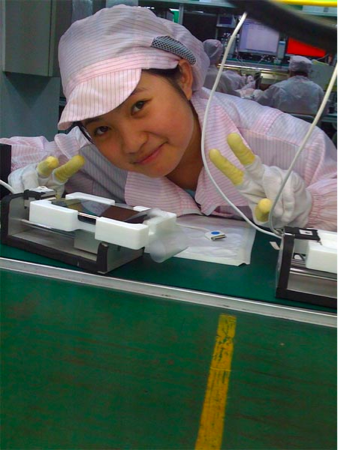Inside Foxconn City

Editor’s Note (3/16/2012): This American Life retracted its airing of Mr. Daisey’s Foxconn monologue, expressing concern over whether the events Mr. Daisey describes at the plant were factual or dramatized for theatrical purposes. Read more here.
With the rising emergence of automation in the manufacturing world, brought on by increasing global competition and reinforced by events like Foxconn’s plan to integrate over 1 million robots into its assembly lines, it’s easy to forget that the vast majority of our electronic products are still largely assembled by hand.
One Foxconn plant in Shenzhen, China, referred to as Foxconn City for its massive size, is particularly well known for its use (read: abuse) of manual labor in the assembly of products for popular companies like Apple, Sony, Dell and more. The plant employs over 340,000 workers and has had dozens of workers commit suicide due to intolerable working conditions. Just recently, 150 workers threatened suicide over a severance pay dispute, and one worker passed away after completing a 34-hour work shift.
One Apple lover’s journey inside Foxconn
Last week, Ira Glass from Chicago Public Radio’s This American Life shared an excerpt from a monologue performed by Mike Daisey, a self proclaimed “lover of all things technology,” who ventured into the factory that assembles so many of his beloved products.
Disguised as a businessman, Daisey witnessed firsthand the bleak working conditions in the Shenzhen Foxconn plant—and came out of the experience with a profoundly altered view on, as he says, everything.
Below are a few poignant excerpts from Mr. Daisey’s recount of his visit to the plant:
Industrial spaces with 30,000 workers in a single enormous space. They can exert a kind of eerie fascination. There is a beauty to industrialization on such a massive scale, you don’t have to deny it. There is a wonder to seeing so much order laid out before you.
They work on the line, and the line only moves as fast as the slowest member. Each person learns how to move perfectly as quickly as possible. If they can’t do it, there are people behind them watching them and there are cameras watching both sets of people and people watching the cameras. They lock it down. They sharpen it, to a fine sharp edge.
The dormitories are cement cubes—12 foot by 12 foot. And in that space, there are 13 to 15 beds. They are stacked up like Jenga puzzle pieces all the way to the ceiling. The space between them is so narrow. None of us would actually fit into them; they have to slide into them like coffins. There are cameras in the rooms; there are cameras in the hallways; there are cameras everywhere.
As a consumer, where do you draw the line?
Manual labor is still an attractive option for companies like Foxconn because, in countries like China, the cost of labor is effectively zero and the efficiency of these factories is unparalleled. But many activist groups around the world are protesting the consequences of pushing human factory workers to the level of productivity that our vigorous modern consumer buying cycles demand.
In this excerpt, Daisey questions who ultimately carries the responsibility for change:
In my first two hours of my first day at that [Foxconn] gate, I met workers who were 14 years old, 13 years old, 12 years old. Do you really think Apple doesn’t know? In a company obsessed with the details? With the aluminum being milled just so; with the glass being fitted perfectly into the case? Do you really think it’s credible that they don’t know?
Or do you think that they’re just doing what we’re just doing? Do they just see what they want to see?
The truth is, factories like Foxconn turn a blind eye to underage employees, bypass commonly accepted working hours, and foster an oppressive work environment because, well, they can. There are enough gadgets being ordered by companies and demanded by consumers to keep Foxconn’s production lines running 24/7.
How Apple sees it
For companies like Apple, going overseas feels like their only option to staying on top of the demand. When Apple redesigned its iPhone screen in the last minute, for example, it needed a factory that could pull off an assembly line overhaul—waking 8,000 workers in the middle of the night to start a 12-hour work shift fitting new glass screens into iPhone frames. Only a place like Foxconn City can deliver this kind of efficiency and speed.
And while it’s true that factory wages in China are less than what American factories would be required by law to pay, the decision to outsource is not just about Apple saving money. For Apple CEO Timothy D. Cook, the decision to outsource assembly to Asia came down to two things—factories in Asia can “scale up and down faster” and “Asian supply chains have surpassed what’s in the U.S..”
Jennifer Rigoni, Apple’s worldwide supply demand manager until 2010, explains Apple’s logic like this: “They [Foxconn] could hire 3,000 people overnight. What U.S. plant can find 3,000 people overnight and convince them to live in dorms?”
So what do you think? Is this our new reality or is there a way to bring factory jobs back home?
Listen here for the entire monologue of Mr. Daisey’s trip to the Foxconn plant in Shenzhen.


